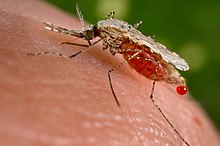Anopheles stephensi
| Anopheles stephensi | |
|---|---|
 |
|
| Scientific classification | |
| Kingdom: | Animalia |
| Phylum: | Arthropoda |
| Class: | Insecta |
| Order: | Diptera |
| Family: | Culicidae |
| Genus: | Anopheles |
| Species: | A. stephensi |
| Binomial name | |
|
Anopheles stephensi Liston, 1901 |
|
Anopheles stephensi is a primary mosquito vector of malaria in urban India and is included in the same subgenus as Anopheles gambiae, the primary malaria vector in Africa.A. gambiae consists of a complex of morphologically identical species of mosquitoes, along with all other major malaria vectors, however, A. stephensi has not yet been included in any of these complexes. Nevertheless, two races of A. stephensi exist based on differences in egg dimensions and the number of ridges on the eggs: A. stephensi stephensi sensu stricto, the type form, is a competent malaria vector that takes place in urban areas, and A. stephensi mysorensis, the variety form, exists in rural areas and exhibits considerable zoophilic behaviour, making it a poor malaria vector. However, A. stephensi mysorensis is a detrimental vector in Iran. An intermediate form also exists in rural communities and peri-urban areas, though its vector status is unknown. About 12% of malaria cases in India are due to A. stephensi.
In November 2015 an American research group demonstrated that an Anopheles stephensi with genetic modifications could be rendered incapable of transmitting malaria, and that 99.5 percent of the mutant mosquitoes' offspring were also immune.
In rural areas, the larvae of A. stephensi may exist in many aquatic habitats, such as: ponds, streams, swamps, marshes, and other sources of standing water. They may also occupy smaller environments, such as: tree holes, leaf axils, and man-made containers. Though larvae of A. stephensi mysorensis exclusively prefer to occupy stone pots and earthenware containers. This species is also able to endure high amounts of salinity, and have been found to breed readily in water where the salinity is equal to or even surpassing that of sea water. Furthermore, A. stephensi breeds in a number of different water-bodies in urban areas, but predominantly in artificial containers, walls, overhead tanks, and ground level water tanks.
Most larvae feed on microorganisms and particle matter that is suspended in water. However, later in development, adult males will feed on the nectar of flowers, whereas females will take blood meals, which help produce viable eggs.
A. stephensi is a sub-tropical species that predominates in the Indian subcontinent (except Nepal and Sri Lanka) and is also distributed across the Middle East and South Asia region, existing in countries such as: Afghanistan, Bahrain, Bangladesh, China, Egypt, India, Iran, Iraq, Oman, Pakistan, Saudi Arabia, and Thailand.
...
Wikipedia
